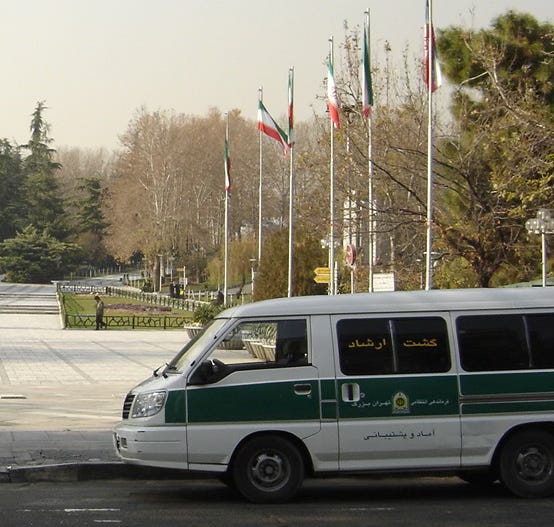Cultural Policing and Religious Control in Iran: From “Sacred Dolls” to the Hijab Enforcement Campaign
Two parallel developments in Iran — the judicial crackdown on so-called “fantasy dolls” named Morteza and Marziyeh and the launch of a vast new hijab enforcement initiative deploying tens of thousands of morality enforcers — have reignited public debate about the growing convergence of religion, law, and surveillance in Iranian society. Together, these incidents reflect a deepening state strategy to police culture and behavior under the banner of defending Islamic values, while critics warn that such measures are eroding personal freedoms and widening the gap between the government and the public.
The Tehran Prosecutor’s Office recently announced that it had ordered judicial investigators to identify and prosecute those responsible for producing and distributing Morteza and Marziyeh — soft anti-stress toys shaped like animals such as pigs and gorillas. Hardline media and religious activists condemned the toys for allegedly “insulting sanctities”, arguing that naming them after revered figures — Morteza being one of Imam Ali’s honorifics and Marziyeh associated with Fatemeh Zahra, the Prophet Muhammad’s daughter — amounted to mocking religious symbols.
Opponents claimed that the toys’ use as items meant to be squeezed or struck symbolically disrespected holy names. The resulting campaign led to the judiciary’s intervention, despite growing criticism from psychologists and cultural commentators who viewed the move as an example of moral overreach and censorship. They noted that such “fidget toys” are common globally and serve therapeutic purposes, not blasphemous ones. Legal experts including Ali Najafi Tavana argued that no criminal intent can be established without proven intention to offend, emphasizing that the judiciary’s reaction blurred the line between law and personal piety.
What began as a minor product controversy has since become a symbolic battle over cultural control, echoing past crackdowns on Western-branded dolls like Barbie, which officials once labeled a threat to Iran’s religious identity. This time, however, the products in question were made and sold legally within Iran, raising deeper concerns about how far authorities will extend religious scrutiny into everyday life.
At the same time, the government has launched a far-reaching new campaign to enforce the compulsory hijab law, combining physical monitoring with digital and community surveillance. On October 17, 2025 (25 Mehr 1404), Rouhollah Momen-Nasab, secretary of the Tehran Headquarters for the Promotion of Virtue and Prevention of Vice, announced the creation of an “Hijab and Modesty Situation Room” — a coordination body linking cultural, judicial, and security institutions. Momen-Nasab revealed that over 80,000 “morality enforcers” and 4,575 judicial instructors are being mobilized to carry out what he described as a “great transformation” against “secularism and social apathy.”
The new structure integrates citizen surveillance networks through what authorities call the “Public Observers Command,” encouraging ordinary citizens to report “improper” dress or behavior in public, educational, and even digital spaces. Momen-Nasab stated that the Situation Room would analyze cultural trends, monitor online content, and coordinate with the judiciary and cyber police (FATA) to investigate and prosecute “norm-breaking” acts, including social media posts deemed contrary to public morality.
Despite these new measures, large segments of Iranian women continue to openly defy the compulsory hijab law, appearing unveiled in public spaces, shops, and universities. Social media platforms are filled with images of women walking freely without headscarves, signaling a widespread act of civil disobedience. Even some politicians aligned with the establishment — including Mohammadreza Bahonar, a veteran conservative figure and former deputy speaker of parliament — have publicly stated that the hijab should not be enforced through coercion. In this atmosphere of resistance and fatigue, it appears unlikely that the new hijab enforcement plan will have a significant impact or compel women to comply. This is especially true since Iran’s Supreme National Security Council has reportedly confirmed that the hijab law is not legally enforceable under current regulations, further complicating the government’s effort to implement it through administrative or moral channels.
Critics inside and outside Iran describe these developments as part of a broader campaign of “Talibanization” of public life — an effort to formalize citizen-on-citizen surveillance while using religion as a legal tool for control. They warn that deputizing tens of thousands of informants risks creating a climate of fear, mutual suspicion, and social fragmentation, undermining trust within communities and further isolating women who resist compulsory dress codes.
Both the “sacred dolls” investigation and the new hijab enforcement policy reveal how the Iranian state continues to use religion not only as a moral guide but as a governing instrument. In this framework, cultural expression, psychological tools, and even consumer products are subject to scrutiny through the lens of ideological purity.
For many Iranians — especially younger generations shaped by the Woman, Life, Freedom protests in 2022 — such measures reinforce the perception of a government out of step with societal realities. Public frustration is evident online, where users mock the crackdown as misplaced priorities amid economic hardship and social unrest.
Ultimately, these two episodes expose a deeper truth: Iran’s ruling establishment is doubling down on religious enforcement as a means of political control, even at the cost of alienating much of its population. Whether targeting toys or clothing, the state’s message remains the same — the boundaries of faith, law, and personal life will continue to be defined from above, not negotiated from below.
Photo courtesy of Wikimedia.

